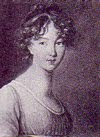
A second, much lighter weight Knitted Hood from Peterson’s Magazine, September, 1861. I knit this one in Templetons’s H&O Shetland Fleece in Dusky Blue and White on 6.5mm/10 ½ US needles. The monotony of knitting this hood was greatly relieved by the fact that I love this wool so I was quite happy to have it flowing through my fingers.
My other hood turned out rather heavy but was so very warm during last year’s bitter winter. I had used a thicker wool than the original pattern’s 19th century’s “Shetland wool,” which is closer in weight to the Templeton’s. Two separate, identical pieces are to be knit and then sewn together but for this second hood, I only knit one piece and folded it over to sew it up. I kept to the original number of rows but added stitches on both sides to the long bands for tying so I could wrap them around my neck and then tie them in front. I made tassels again, as suggested in the text of the original pattern, and used blue and white wool as stated in the pattern.
The photo below shows another Princess Royal’s Scarf from Godey’s Lady’s Book, March, 1856, knit, again, in KnitPicks’s Palette, this time in Edamame and Mustard, on 4.5mm/7 US needles. I had to add thirty-two stitches to each side again to make it long enough and to match the illustration. I went with long tassels again, and not the spikey pompons (called "tassels" and "balls") as in the illustration. Although I modeled the last scarf I made, I gave it away so this one is for me!








